Best Ways to Reduce Eliminate Hydraulic Oil Leakage
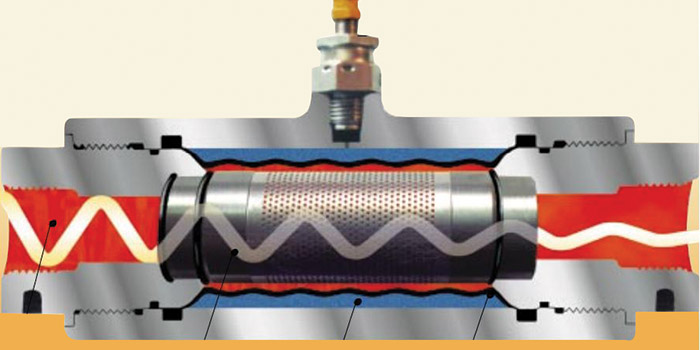 Hydraulic oil in a pressure line can travel at a speed of 15-30 feet per second, depending on the pressure. When a valve is rapidly closed to block flow or a cylinder fully strokes, a pressure spike will occur.
Hydraulic oil in a pressure line can travel at a speed of 15-30 feet per second, depending on the pressure. When a valve is rapidly closed to block flow or a cylinder fully strokes, a pressure spike will occur.
Unlike air, hydraulic oil is generally considered to be non-compressible. Oil will only compress 0.5 percent when pressurized to 1,000 psi. When a pressure spike occurs in the system, the pressure can increase four or five times above the normal operating pressure.
Since the average duration of a shock spike is 25 milliseconds, the pressure gauge cannot respond fast enough to give an accurate indication. Pressure transducers are normally used to record pressure spikes. Shock spikes that are not properly dampened or absorbed can result in leakage and damage to the lines and components in the system. One drop of oil that drips once per second will result in a loss of 405 gallons in a year’s time. At the cost of $9 per gallon, that one leak costs $3,645 in one year.
Shock Suppressors
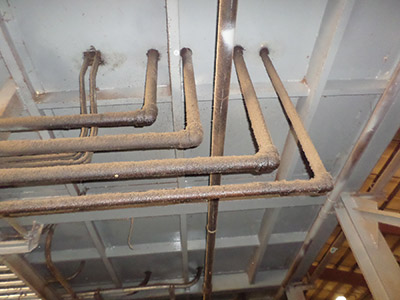 A shock suppressor acts very much like a hydraulic accumulator except that it can be mounted directly in the line. The suppressor is pre-charged with dry nitrogen. The rubber bladder separates the nitrogen from the oil. The recommended pre-charge of nitrogen is half the maximum system pressure. The suppressor should be installed as close as possible to where the shock is occurring. For example, if shock is generated by the rapid closing of a directional valve, install the suppressor near the pressure port of the valve. When the valve rapidly closes and the shock spike occurs, the nitrogen will compress and absorb the pressure spike. The suppressor is also useful in systems that contain 90-degree bends in the piping or tubing. An additional benefit of the shock suppressor is that it also reduces noise. This can be useful in systems that utilize high-volume pumps and/or accumulators.
A shock suppressor acts very much like a hydraulic accumulator except that it can be mounted directly in the line. The suppressor is pre-charged with dry nitrogen. The rubber bladder separates the nitrogen from the oil. The recommended pre-charge of nitrogen is half the maximum system pressure. The suppressor should be installed as close as possible to where the shock is occurring. For example, if shock is generated by the rapid closing of a directional valve, install the suppressor near the pressure port of the valve. When the valve rapidly closes and the shock spike occurs, the nitrogen will compress and absorb the pressure spike. The suppressor is also useful in systems that contain 90-degree bends in the piping or tubing. An additional benefit of the shock suppressor is that it also reduces noise. This can be useful in systems that utilize high-volume pumps and/or accumulators.
System Piping and Hoses
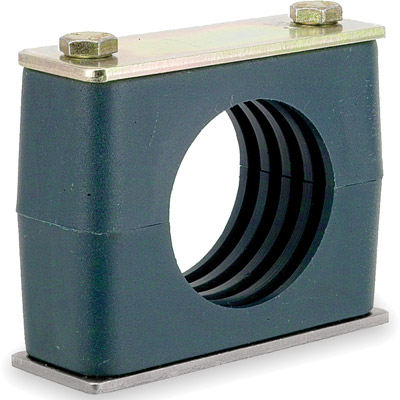 When plumbing a system, eliminate the use of 90-degree fittings in the pipe and tubing. When oil enters the fitting at a high velocity and rapidly takes a 90-degree turn, turbulence will exist and shock will be generated. This will result in leakage at the fitting or elbow. A 45- or 90-degree sweep ell will reduce the turbulent flow as the oil flows through the line.
When plumbing a system, eliminate the use of 90-degree fittings in the pipe and tubing. When oil enters the fitting at a high velocity and rapidly takes a 90-degree turn, turbulence will exist and shock will be generated. This will result in leakage at the fitting or elbow. A 45- or 90-degree sweep ell will reduce the turbulent flow as the oil flows through the line.
Proper clamping is essential to reduce shock in the system. In the photo below, U-bolts have been used to clamp the pipes. In this installation, you can see that the pipe has moved due to hydraulic shock. This eventually will lead to wearing of the pipe and leakage. U-bolts, conduit clamps and beam clamps are not built to withstand the shock in a hydraulic system.
A proper hydraulic clamp should be used (as shown in the photo below). Clamps should be spaced every 5-8 feet, depending on the size of the line, and must be tightened on a regular basis to eliminate movement of the pipe and subsequent leakage. A clamp should also be installed within 6 inches of the termination point.
When properly placed, hoses can absorb shock in the system. A hose should be installed at the outlet of the pump prior to entering the manifold or main header. This will reduce shock at the pump when the oil flow is rapidly deadheaded.
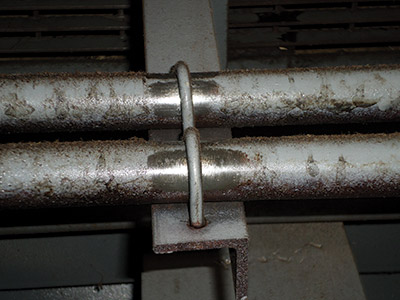 Hoses should also be installed prior to connecting to a valve, manifold or cylinder. The only exception is if the cylinder is mounted vertically. In these applications, pilot-operated check valves or counterbalance valves are used to maintain oil in the cylinder when in the raised position. The hose should therefore be installed before the check or counterbalance valve.
Hoses should also be installed prior to connecting to a valve, manifold or cylinder. The only exception is if the cylinder is mounted vertically. In these applications, pilot-operated check valves or counterbalance valves are used to maintain oil in the cylinder when in the raised position. The hose should therefore be installed before the check or counterbalance valve.
Be sure to make the hose long enough, as its length can change when the pressure spike occurs. On the other hand, hoses should not be made too long either, as they will rub on another hose, catwalk, beam or other structure.
Pressure Settings
Pressures are often randomly adjusted by the local plant knob-turner in an attempt to increase the speed of the machine. When a cylinder or hydraulic motor operates, the pressure will only build up high enough to move the load. Therefore, the maximum pressure limiter in the system should be set 200 psi higher than the pressure required to move the load. If the pressure is set higher than that, excessive shock will be generated when starting and stopping the actuator.
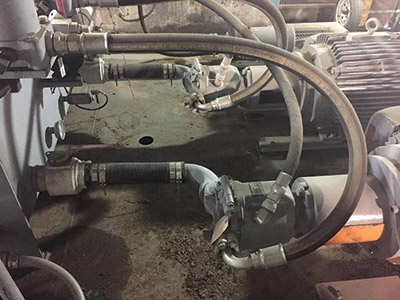 In a system with a pressure-compensating type pump, the compensator setting determines the maximum system pressure. When this pressure is reached, the compensator spool will shift open and de-stroke the pump. The pump will then only deliver enough oil to maintain the compensator setting.
In a system with a pressure-compensating type pump, the compensator setting determines the maximum system pressure. When this pressure is reached, the compensator spool will shift open and de-stroke the pump. The pump will then only deliver enough oil to maintain the compensator setting.
In a fixed-displacement pump system, the relief valve determines the maximum system pressure. Once the relief valve’s spring setting is reached, the spool will shift open and port the pump volume back to the tank.
I was recently asked to consult with a sawmill that was experiencing leakage and shock on its lumber stacker. The stacker used a 10-inch-diameter cylinder to raise and lower the stack. The hydraulic schematic recommended that the relief valve be set to 1,200 psi. However, someone had turned the valve up to 1,800 psi. When the cylinder fully bottomed out, the pressure went up to 1,800 psi. A loud bang was then heard, and all lines in the system vibrated.
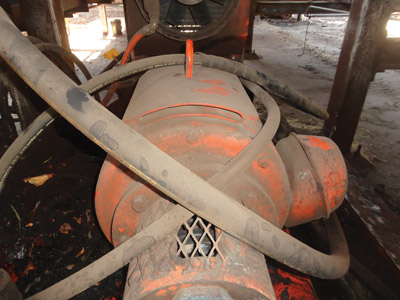 You can calculate how much force was generated when the pressure built up to 1,800 psi using the following formula:
You can calculate how much force was generated when the pressure built up to 1,800 psi using the following formula:
Force = Pressure x the number of square inches on the full piston side of the cylinder
Force = 1,800 psi x 78.54 square inches
Force = 141,372 pounds
Once the relief valve setting was lowered to the recommended 1,200 psi, the noise and shock severely decreased when the cylinder bottomed out. With the pressure at 1,200 psi, you can calculate the amount of force that was reduced on the cylinder using the same formula:
Force = 1,200 psi x 78.54 square inches
Force = 94,248 pounds
The difference in force between 1,800 psi and 1,200 psi is 47,124 pounds or almost 24 tons.
All plant personnel should be made aware of the negative effects caused by pressures being out of adjustment. In addition to reducing shock and leakage, turning down pressures decreases electrical energy consumption of the electric motor and heat generation in the system.
If you have shock and leakage in your systems, there is something you can do about it. By properly setting the pressures, installing accumulators and shock suppressors where needed, verifying that the system is piped and hosed correctly, and adding or adjusting pilot chokes, you should be able to reduce or even eliminate shock and leakage in your hydraulic systems.
